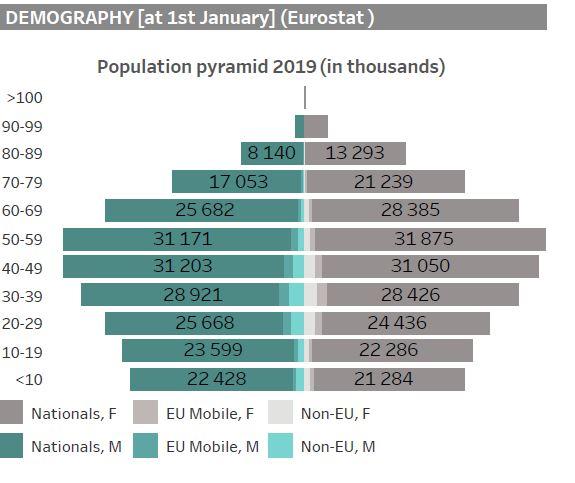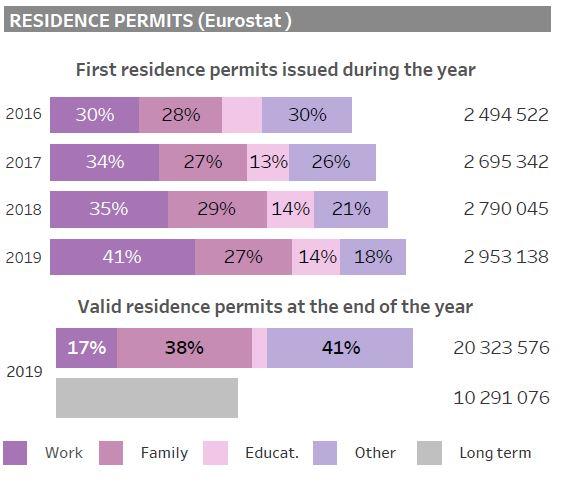
On International Migrants’ Day, the European Commission Knowledge Centre on Migration and Demography launches the 2020 edition of its online, interactive Atlas on Migration with a new section on the impact of COVID-19 on migration and updated indicators for 198 countries and territories worldwide.
Research suggests that the ongoing COVID-19 pandemic and the government responses to it could reshape migratory movements, shift migration routes and alter the composition of migrant populations worldwide.
It is not only the size and composition of migratory movements that is being affected, but also key characteristics, such as the routes people take and the decisions on when to move: those are all rapidly changing.
Due to mobility restrictions or fear of the virus, many migrants could not reach their place of employment. Others have returned to their country of origin after becoming jobless, and some are missing opportunities to study or to reunite with family.
Also some labour migration programmes have been suspended and asylum procedures delayed. On the other hand, many migrants have played a vital role in responding to the pandemic through their roles as key workers in essential services, or by offering their support and solidarity to those in need. Overall, 13% of key workers in the EU-27 are migrants.
The economic crisis triggered by the pandemic is heavily affecting migrants as well. It affects the countries where migrants live and work, as well as their countries of origin, where they send remittances.
Remittances are a vital source of income for millions of households in developing countries. They undergo an unprecedented decline due to the coronavirus crisis: in 2020 the World Bank forecast an unprecedented 7% annual reduction in the scale of global remittance flows.
It is expected that this decline will continue into 2021. The pandemic would thus magnify some structural fragilities in the developing countries.
For these reasons, in the new 2020 edition of the Atlas of Migration, JRC researchers bring together the most up to date international migration-related data available to help understand the current situation, observe potential new trends and compare between countries and regions in order to shed light on the possible consequences of the COVID-19 crisis on migration.
What is the Atlas of Migration?
The Atlas is an online reference tool guiding policy-makers, practitioners and the general public through the complexities of migration and demography. It brings together harmonised, validated and updated indicators related to migration, asylum, integration, demography, and development from 12 international data sources.

Its traditional sections contain updated country profiles for each of the 27 EU Member States and for 171 countries and territories around the world.
The online version of the Atlas is an ideal tool both for evidence-based policymaking and to support the implementation of those policies, such as the New Pact on Migration and Asylum. This year’s edition also includes new continent factsheets, supporting the country profiles with a continental perspective.
Atlas confirms increase in legal migration to the EU in 2019 prior to the COVID-19 outbreak, with the largest share moving for work
In 2019, 2.9 million people were granted residence permits in the EU, an increase from 2.8 million in 2018. Of those who came from countries outside the EU during 2019:
- 41% did so with a permit for work;
- 27% for family purposes;
- 14% for education;
- the remaining 18% for various reasons including all forms of international protection.

The COVID-19 pandemic is likely to have significant implications for this trend. However, some EU Member States which tend to have the most annual immigration, such as Italy, Spain and France, have had some of the largest COVID-19 caseloads. The number of residence permits granted by OECD countries in the first semester of 2020 fell by 46% compared with the same period in 2019, although the implications for the EU-27 are yet to be fully understood.
How did the pandemic affect trends in asylum applications and irregular border crossings?
A clear consequence of the pandemic is visible in the monthly number of asylum applications in the EU, which fell considerably this year as the coronavirus hit Europe; in the first seven months of 2020, there were fewer than 233k applications, compared to more than 355k for the same period in 2019.
As concerns irregular border crossing, the Atlas shows that overall, they fell by 7,695 (-24%) between January and August 2020 compared to the same period in 2019. However, some routes saw an increase: Central Mediterranean (an increase of 14,103), Western Africa (3,299) and the Western Balkans. Others saw a decline: the (Eastern Mediterranean (decline of 24,445) and Western Mediterranean (6,645) routes.
The Atlas also maps the extent and timescale of the crisis, showing how COVID-19 rapidly propagated around the world from a single city to a global pandemic, accompanied by the swift implementation of government restrictions seeking to restrict its spread around much of the world. Together, these two processes have had wide-reaching implications for mobility and migration over the course of 2020.
Background
While data on migration and demography is available, it is often widely dispersed and quite complex to access and understand.
Citizens who want to understand the facts behind migration may find it difficult. The same is valid for policymakers wishing to inform migration policies with the best evidence. The Atlas of Migration is an ideal customisable tool to access global migration data visually organised and presented in an easy-to-understand way.
With the release of the New Pact on Migration and Asylum, the von der Leyen Commission proposed “a fresh start on migration” aimed at building confidence through more effective procedures and striking a new balance between responsibility and solidarity of Member States.
The Knowledge Centre on Migration and Demography, co-chaired by the Commission’s JRC and Directorate-General for Migration and Home Affairs, contributes to the implementation of the new Pact on Migration and Asylum by building evidence and foresight informing the EU’s approach.
Related Content
Details
- Publication date
- 18 December 2020
